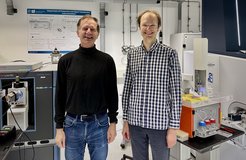Understanding the single cell proteome in the context of their tissue
Researchers led by Matthias Mann at the Max Planck Institute (MPI) of Biochemistry developed a new approach to proteomics that enables the long-awaited single-cell resolution on intact tissue.
Similar to humans and animals, which adapt their diet or behavior to given environmental conditions, the function and protein composition of single cells also depends on which resources are available in their immediate environment. Using a new approach developed by a research team led by Matthias Mann, Director at the MPI of Biochemistry, it is now possible to analyze this protein composition with a view to the environment of individual cells for the first time. By combining two new methods from the research department, they succeeded in functionally mapping the proteome of single cells with high spatial resolution. The results are published in the journal Nature Methods.

Tissues consist of many different cell types, each of which performs specific functions in our body. Even within such a cell type category, however, the function of each cell depends on the environment in which it is located, as for example, whether there are blood vessels near it or which other cells are located around it. Are there many usable nutrients? How much oxygen is available to the cell? What hormonal signals are influencing it?
This connection between function and location is particularly strong in the liver. The liver, as the central metabolic organ of the body, consists of 85% of one cell type, called hepatocytes. These cells perform various metabolic tasks in our body, such as storing glucose or detoxifying our blood. In these metabolic processes, the respective proteins within the cells are of crucial importance. Until now, however, it has not been possible to measure and visualize the proteome of individual liver cells in relation to their immediate environment.
Deep Visual Proteomics - a revolutionary method further developed
Researchers have now succeeded in closing this gap with a technological milestone. The team led by Matthias Mann, Director at the MPI of Biochemistry, developed the Deep Visual Proteomics method in 2022 to determine the proteome of individual cell types. During analysis with Deep Visual Proteomics, cells of one type are identified, extracted and sorted into specific groups after a tissue sample has been taken. They are then analyzed for their protein composition using mass spectrometry.
"In our new study, we have merged two worlds. We have combined a method called single-cell proteomics with the spatial resolution of Deep Visual Protemics to create a new approach to single-cell proteomics with spatial resolution. The new approach, Single-Cell Deep Visual Proteomics, now allows us to measure more than two thousand different proteins of single cells in intact tissue with spatial resolution for the first time," explains Florian Rosenberger, first author of the recent study. "As a result, we are now able to precisely localize hundreds of metabolic pathways," Rosenberger continues. Using this, protein maps can now be created that help to better understand the mechanisms of health and disease.
By combining the two existing methods, the authors were also able to show that neighboring cells sometimes display enormous functional differences. Up until now, such variations could only be shown for a few proteins. This new approach, published in the journal Nature Methods, paves the way for a better understanding of complex tissues such as tumors. As a result, it is now also possible to identify individual cells and their mechanisms, which, for example, lead to resistance in cancer therapies.
"We have a historical novelty with first single cell proteomics analysis directly in the tissue context and the angle that same cell types actually do quite different things depending on where they are located. We are convinced that in just a few years we will be able to measure almost the entire proteome of a cell, with more than 10,000 proteins in just a few minutes," concludes Matthias Mann.
[tb]

Dictionary of the Department of Proteomics and Signal Transduction
Proteome: The proteome includes the totality of all proteins in a living organism, tissue, or cell at a given time. It is highly dynamic and responds to the demands of the cell, as well as to disease or environmental factors.
Proteomics: Proteomics is the study of the proteome.
Mass spectrometry: Mass spectrometry is a method for determining the mass and abundance of charged particles.
Deep Visual Proteomics: Deep Visual Proteomics, or DVP for short, is a method developed in the department of Matthias Mann in 2022. The method combines advanced microscopy, machine learning, laser microdissection, and ultra-sensitive mass spectrometry with subsequent bioinformatics analysis.













